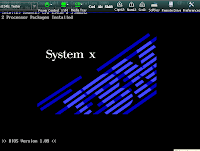The IBM Blade Chassis Hardware Topology Inventory details
The IBM Blade Server that located in the IBM Blade Chassis
I want to describe hardware details and base operating system before virtual system because, this may affect virtual parts. Actually this risc is really very low for VirtualBox versus OpenVZ. Because there are criterias of hardware compatibility for other virtualization products. I'm going to use a Ubuntu Server 11.10 for base operation system so this OS is used by most of the people. Also I'm going to select a 64 bit operation system to able to use 64 bit virtual systems.
Mount iso image, and check KVM and media tray and power on as show in following movie.
The Youtube Link : http://www.youtube.com/watch?v=LbyBYN_YiyM
Ubuntu 11.10 Server AMD 64 bit OS installation steps are shown in following pictures: (These pictures show the steps that are almost all in default. You may want to jump if you wish.)
VirtualBox Installation;
1-) Add one of the following lines according to your Ubuntu server to your /etc/apt/sources.list
deb http://download.virtualbox.org/virtualbox/debian oneiric contrib
deb http://download.virtualbox.org/virtualbox/debian natty contrib
deb http://download.virtualbox.org/virtualbox/debian maverick contrib non-free
deb http://download.virtualbox.org/virtualbox/debian lucid contrib non-free
deb http://download.virtualbox.org/virtualbox/debian karmic contrib non-free
deb http://download.virtualbox.org/virtualbox/debian hardy contrib non-free
deb http://download.virtualbox.org/virtualbox/debian squeeze contrib non-free
deb http://download.virtualbox.org/virtualbox/debian lenny contrib non-free
Actually I need adding only the first line for my OS because, my ubuntu distribution is Oneiric. But your distribution may have a different version, so I write other distributions.
2-) Downloading the Oracle public key for apt-secure and registering:
support@tester:~$ wget http://download.virtualbox.org/virtualbox/debian/oracle_vbox.ascsupport@tester:~$ sudo apt-key add oracle_vbox.asc
or
support@tester:~$ wget -q http://download.virtualbox.org/virtualbox/debian/oracle_vbox.asc -O- | sudo apt-key add -
3-) Installing virtualbox-4.1:
support@tester:~$ sudo apt-get update
support@tester:~$ sudo apt-get install virtualbox-4.1
4-) Downloading extension pack:
support@tester:~$ wget http://download.virtualbox.org/virtualbox/4.1.8/Oracle_VM_VirtualBox_Extension_Pack-4.1.8-75467.vbox-extpack
5-) Installing the extension pack for Oracle VirtualBox. If we don't install extension pack, we won't be able to use remote display features. So our system hasn't got GUI yet, we can not start to install virtual system without extension pack. To install extension pack,
support@tester:~$ VBoxManage extpack install Oracle_VM_VirtualBox_Extension_Pack-4.1.8-75467.vbox-extpack
You can find all of the official instructions and installation packages in https://www.virtualbox.org/wiki/Downloads .
You can watch these instructions on following movie:
The Youtube Link; http://www.youtube.com/watch?v=HmN0xhB1znU
You can visit http://stdioe.blogspot.com/2012/01/creating-virtual-machine-with.html to read "Creating virtual machines using VBoxManage command" article. It is the next step of this article.














































